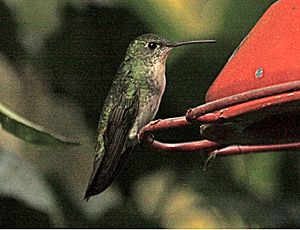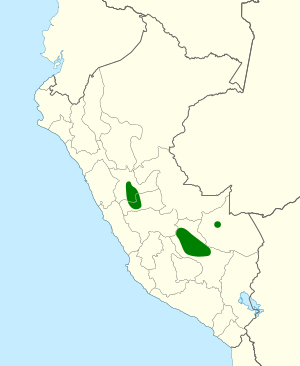Green-and-white hummingbird facts for kids
The green-and-white hummingbird (Elliotomyia viridicauda) is a small, colorful bird that belongs to the hummingbird family. It's known for its bright green and white feathers. This special bird lives only in Peru, a country in South America.
Quick facts for kids Green-and-white hummingbird |
|
|---|---|
 |
|
| Conservation status | |
| Scientific classification | |
| Genus: |
Elliotomyia
|
| Species: |
viridicauda
|
 |
|
| Synonyms | |
|
|
Contents
How Scientists Classify This Bird
Scientists group living things into categories to understand how they are related. This is called taxonomy. The green-and-white hummingbird has had a few different scientific names over the years.
- It was once placed in groups called Leucippus and Elliotia.
- For a long time, it was part of the Amazilia group.
- In 2014, scientists studied the birds' DNA (their genetic code). They found that the Amazilia group wasn't organized in the best way.
- Because of this, most scientists moved the green-and-white hummingbird into a new group called Elliotomyia.
- This bird is the only one of its kind, meaning it doesn't have different subspecies. It shares its group, Elliotomyia, with another bird called the white-bellied hummingbird.
What It Looks Like
The green-and-white hummingbird is about 10 to 11 centimeters (4 to 4.3 inches) long. That's about the length of an adult's hand!
- Males weigh around 6 grams (0.2 ounces), which is lighter than a single grape.
- Females are a bit lighter, weighing about 5.5 grams (0.19 ounces).
- Both male and female birds have a straight beak that's medium in length. The top part of the beak is blackish, and the bottom part is reddish with a dark tip.
- Adult males are a shiny green to bronze-green on their backs and sides. Their bellies are whitish, with some green spots on their chin and throat. Their tail feathers are grayish-green or golden-green.
- Adult females look very similar to males, but their chin and throat are a light cream color with more spots.
- Young birds look like adult females, but the cream color on their throat extends down to their belly.
Where It Lives and Its Home
The green-and-white hummingbird lives on the eastern side of the Andes mountains in Peru. You can find it in different areas from the Huánuco Department south to the Cuzco Department. This includes the famous ancient city of Machu Picchu.
These hummingbirds like to live in:
- The edges of grown-up subtropical forests.
- Open areas within these forests.
- Newer forests that have grown back after old ones were cut down (called secondary forests).
They live at elevations between 1,000 and 2,500 meters (3,300 to 8,200 feet) above sea level.
Behavior
Movement
The green-and-white hummingbird usually stays in the same area and doesn't travel far. However, sometimes individual birds might move to nearby places.
Feeding
These hummingbirds get their food from many different kinds of flowering plants, bushes, and trees. They mainly drink nectar, which is a sweet liquid from flowers. They also eat small arthropods, which are tiny insects and spiders.
Reproduction
Scientists don't know the exact full breeding season for the green-and-white hummingbird, but they know it includes January.
- The bird builds a cup-shaped nest using soft plant fibers.
- It uses spiderwebs to hold the nest together and decorates the outside with lichen (a type of moss-like growth).
- Nests are often placed on a horizontal branch of a small tree.
- The time it takes for the eggs to hatch and for the young birds to leave the nest is not yet known.
Vocalization
The green-and-white hummingbird has a special song and call:
- Its song is a short phrase repeated over and over, usually with three squeaky notes. It sounds like "tseet-chew-chip … tseet-chew-chip ..."
- Its call starts with two high-pitched notes that go up, followed by a series of notes that go down. It sounds like "tsee-tseeet-tsi-tsi-tsi-tsi."
- Both its song and call are very similar to those of its close relative, the white-bellied hummingbird.
Conservation Status
The IUCN (International Union for Conservation of Nature) has evaluated the green-and-white hummingbird. They have listed it as a species of Least Concern. This means that, for now, it is not considered to be in danger of disappearing.
- Scientists don't know exactly how many green-and-white hummingbirds there are or if their numbers are going up or down.
- No immediate threats to the bird have been found.
- It lives in a specific area, but it's quite common in the Pasco Department and around Machu Picchu.
- More studies are needed to figure out what kind of conservation efforts might be needed to protect this species in the future.
See also
 In Spanish: Amazilia viridicauda para niños
In Spanish: Amazilia viridicauda para niños


